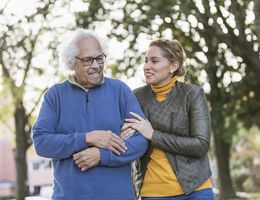Health library
Back to health libraryFaster walking may cut the risk of type 2 diabetes

Dec. 11, 2024—Exercise can help prevent type 2 diabetes—and walking is a simple way to get active. The American Diabetes Association recommends people walk about 30 minutes a day to help keep blood sugar stable and prevent diabetes. Though any amount of walking at any pace beats being sedentary, recent research suggests that walking faster can increase the benefits you get from a walking workout routine.
A new reason to pick up the pace
Regular walking can reduce your risk of type 2 diabetes, and a new study published in the British Journal of Sports Medicine (BJSM) suggests that walkers can increase these benefits by walking faster.
The study analyzed 10 cohort studies that included 508,121 participants in the U.S., Japan and the U.K. who told researchers the speed of their usual walks. Researchers found that brisk walking (2.5 to 5 miles per hour) reduces type 2 diabetes risk more than slower strolls.
Get the highlights from the new research
- The faster people walked, the more they cut their diabetes risk.
- Walkers moving 2 to 3 miles per hour had a 15% lower risk than more leisurely walkers.
- Walking at 3 to 4 miles per hour was associated with a 24% lower risk.
- Walking at a brisk 4 miles per hour reduced type 2 diabetes risk by 39% in the study.
Take the next step
- If you aren’t currently exercising, check with your provider before starting any fitness routine.
- Start slow and work your way up. The first time out, don’t worry about speed. You’ll be able to walk longer and faster as your fitness increases.
- Warm up before increasing your speed. Walk at a comfortable pace for a few minutes before challenging yourself.
- Know when you’re in the zone. During your warm-up, you should be able to talk easily. You’ll know you’re at a moderate pace when it gets harder to have a conversation.
- Make walking more fun by walking with a friend or listening to a podcast, audiobook or music.
- Log your distance, time and speed. Keeping this record can help you set small, realistic goals. It will also motivate you by showing you your progress over time.
- Cool down. After your brisk walk, slow down until your heart rate returns to normal. And stretch to prevent soreness.
You don't need to be a speed-walker to benefit from being physically active. Your body will thank you any time you stop sitting to walk any amount. For more inspiration to get moving, learn about the many benefits of walking.
Sources
- American Diabetes Association. "The Benefits of Walking." https://diabetes.org/health-wellness/fitness/benefits-walking.
- American Heart Association. "Walking Your Way to Better Health? Remember the Acronym FIT." https://www.heart.org/en/news/2022/04/06/walking-your-way-to-better-health-remember-the-acronym-fit.
- British Journal of Sports Medicine. "Walking Speed and the Risk of Type 2 Diabetes: A Systematic Review and Meta-analysis." https://bjsm.bmj.com/content/early/2023/11/14/bjsports-2023-107336.
- HelpGuide.org. "How to Start Exercising and Stick to It." https://www.helpguide.org/articles/healthy-living/how-to-start-exercising-and-stick-to-it.htm.
